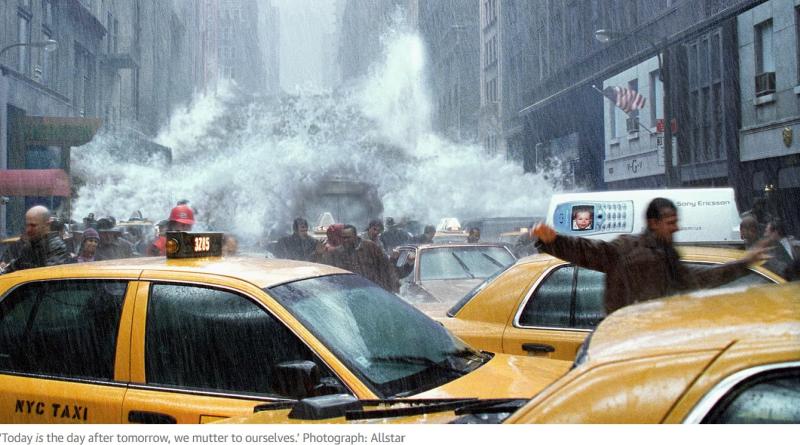In the winter of 2013, a breakdown in the polar vortex allowed freezing cold air to escape southwards towards the North American continent. As ice storms, tornadoes and blizzards swept across the US, Donald Trump tweeted. “I’m in Los Angeles and it’s freezing,” he wrote. “Global warming is a total, and very expensive, hoax!”
It was all a little too reminiscent of Roland Emmerich’s disaster flick The Day After Tomorrow – which opens with US leaders dismissing scientific concerns about the loss of a huge chunk of the Antarctic ice shelf. The researchers are soon vindicated: within days, the melting ice sets off a chain of freak weather events, culminating in a global superstorm that plunges the entire northern hemisphere into a new ice age.
The film, 2004’s summer box office hit, was lampooned by critics and scientists alike. Members of an internet chatroom allegedly paid the paleoclimatologist William Hyde $100 to see it. “This movie is to climate science what Frankenstein is to heart surgery,” he concluded.
Nevertheless, a series of studies showed that the film did sway public opinion about the climate crisis. Twenty years after its release, it remains a unique specimen: a climate disaster blockbuster that adheres to all the tenets of the genre, while also explicitly attributing its carnage to the greenhouse effect.
The Day After Tomorrow largely follows the story of its own fictional paleoclimatologist, Jack (Dennis Quaid), and his sullen teenage maths prodigy son, Sam (Jake Gyllenhaal), who is conveniently stranded in the New York public library with the ethereal nerd-girl of his dreams. As the superstorm hammers New York, Sam and the rest of his entourage survive on Mars bars from vending machines and heat from the books they are forced to set alight. Meanwhile, Jack makes his way painstakingly to the rescue, his nose a healthy shade of red and his stubble sparkling with frost.
Like every disaster film, The Day After Tomorrow is riddled with inaccuracies, cliches and strange displays of machismo (in one scene, Gyllenhaal battles wolves on a frozen ghost ship). But, if anything, the film’s absurdity feels closer to our reality in 2024 than it did in 2004. After all, we live in the age of climate surrealism – it is generally understood that things are going to get weirder as they get worse. Today is the day after tomorrow, we mutter to ourselves, as we read about ancient anthrax-infested reindeer carcasses defrosting in the Arctic Circle.
It helps that Emmerich – a renowned “master of disaster” – understands the genre’s proximity to the sublime: the aesthetic experience that Kant described as beauty and terror tempered by distance. Heat is rot and disease but death by frost is clean – it leaves glittering, sculptural cadavers in its wake. Within this winter-hellscape-wonderland, there are moments that could almost be described as cosy: Sam’s girlfriend might be dying of sepsis but they’re also falling in love by the fire, wrapped up in blankets, while their companions admire old Gutenberg bibles and debate whether Nietzsche should be condemned to the flames or not.
With his everymen protagonists, Emmerich also performs a perfect trick: swapping the frontline of climate disaster from the global south to the global north. US citizens must flee to Mexico and beg for asylum. This might be a cynical device (American audiences only care when Americans die) but it’s also a slyly political manoeuvre, undermining the false message of universalism that thunders practically everywhere else in the film. In this world, as in our own, we are not “all in it together”.
There’s a reason most Hollywood directors have steered clear of climate stories: people go to disaster films not only for the experience of terror but also of relief. All things considered, you can’t blame Emmerich for giving audiences the ending they came for. By the time the storm has cleared, Earth’s climate has been restored to balance, thanks to a convenient phenomenon known as the albedo effect. There’s peace on Earth and Sam wins the girl. For five minutes, while the credits roll, we get to put aside our dread.







